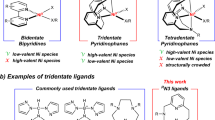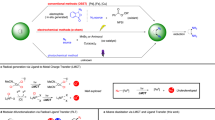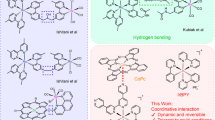Abstract
Visible-light-activated photoredox catalysts provide synthetic chemists with the unprecedented capability to harness reactive radicals through discrete, single-electron transfer (SET) events. This protocol describes the synthesis of two transition metal complexes, [Ir{dF(CF3)2ppy}2(bpy)]PF6 (1a) and [Ru(bpy)3](PF6)2 (2a), that are activated by visible light. These photoredox catalysts are SET agents that can be used to facilitate transformations ranging from proton-coupled electron-transfer-mediated cyclizations to C–C bond constructions, dehalogenations, and H-atom abstractions. These photocatalysts have been used in the synthesis of medicinally relevant compounds for drug discovery, as well as the degradation of biological polymers to access fine chemicals. These catalysts are prepared from IrCl3 and RuCl3, respectively, in three chemical steps. These steps can be described as a series of two ligand modifications followed by an anion metathesis. Using the cost-effective, scalable procedures described here, the ruthenium-based photocatalyst 2a can be synthesized in a 78% overall yield (∼8.1 g), and the iridium-based photocatalyst 1a can be prepared in a 56% overall yield (∼4.4 g). The total time necessary for the complete protocols ranges from ∼2 d for 2a to 5–7 d for 1a. Procedures for applying each catalyst in representative photoredox/Ni cross-coupling to form Csp3–Csp2 bonds using the appropriate radical precursor—organotrifluoroborates with 1a and bis(catecholato)alkylsilicates with 2a—are described. In addition, more traditional photoredox-mediated transformations are included as diagnostic tests for catalytic activity.
This is a preview of subscription content, access via your institution
Access options
Access Nature and 54 other Nature Portfolio journals
Get Nature+, our best-value online-access subscription
$29.99 / 30 days
cancel any time
Subscribe to this journal
Receive 12 print issues and online access
$259.00 per year
only $21.58 per issue
Buy this article
- Purchase on Springer Link
- Instant access to full article PDF
Prices may be subject to local taxes which are calculated during checkout









Similar content being viewed by others
References
Douglas, J.J., Nguyen, J.D., Cole, K.P. & Stephenson, C.R.J. Enabling novel photoredox reactivity via photocatalyst selection. Aldrichim. Acta 47, 15–25 (2014).
Koike, T. & Akita, M. Visible-light radical reaction designed by Ru- and Ir-based photoredox catalysis. Inorg. Chem. Front. 1, 562–576 (2014).
Prier, C.K., Rankic, D.A. & MacMillan, D.W.C. Visible light photoredox catalysis with transition metal complexes: applications in organic synthesis. Chem. Rev. 113, 5322–5363 (2013).
Fukuzumi, S. & Ohkubo, K. Selective photocatalytic reactions with organic photocatalysts. Chem. Sci. 4, 561–574 (2013).
Xi, Y., Yi, H. & Lei, A. Synthetic applications of photoredox catalysis with visible light. Org. Biomol. Chem. 11, 2387–2403 (2013).
Tucker, J.W. & Stephenson, C.R.J. Shining light on photoredox catalysis: theory and synthetic applications. J. Org. Chem. 77, 1617–1622 (2012).
Studer, A. & Curran, D.P. Catalysis of radical reactions: a radical chemistry perspective. Angew. Chem. Int. Ed. 55, 58–102 (2016).
Juris, A. et al. Ru(II) polypyridine complexes: photophysics, photochemistry, electrochemistry, and chemiluminescence. Coord. Chem. Rev. 84, 85–277 (1988).
Duret, G., Quinlan, R., Bisseret, P. & Blanchard, N. Boron chemistry in a new light. Chem. Sci. 6, 5366–5382 (2015).
Hanss, D., Freys, J.C., Bernardinelli, G. & Wenger, O.S. Cyclometalated iridium(III) complexes as photosensitizers for long-range electron transfer: occurrence of a coulomb barrier. Eur. J. Inorg. Chem. 2009, 4850–4859 (2009).
Lowry, M.S. et al. Single-layer electroluminescent devices and photoinduced hydrogen production from an ionic iridium(III) complex. Chem. Mater. 17, 5712–5719 (2005).
Tamayo, A.B. et al. Synthesis and characterization of facial and meridional tris-cyclometalated iridium(III) complexes. J. Am. Chem. Soc. 125, 7377–7387 (2003).
Hopkinson, M.N., Sahoo, B., Li, J.-L. & Glorius, F. Dual catalysis sees the light: combining photoredox with organo-, acid, and transition-metal catalysis. Chemistry 20, 3874–3886 (2014).
Skubi, K.L., Blum, T.R. & Yoon, T.P. Dual catalysis–strategies in photochemical synthesis. Chem. Rev. 116, 10035–10074 (2016).
Levin, M.D., Kim, S. & Toste, F.D. Photoredox catalysis unlocks single-electron elementary steps in transition metal catalyzed cross-coupling. ACS Cent. Sci. 2, 293–301 (2016).
Gui, Y.-Y., Sun, L., Lu, Z.-P. & Yu, D.-G. Photoredox sheds new light on nickel catalysis: from carbon–carbon to carbon–heteroatom bond formation. Org. Chem. Front. 3, 522–526 (2016).
Tellis, J.C., Primer, D.N. & Molander, G.A. Single-electron transmetalation in organoboron cross-coupling by photoredox/nickel dual catalysis. Science 345, 433–436 (2014).
Primer, D.N., Karakaya, I., Tellis, J.C. & Molander, G.A. Single-electron transmetalation: an enabling technology for secondary alkylboron cross-coupling. J. Am. Chem. Soc. 137, 2195–2198 (2015).
Gutierrez, O., Tellis, J.C., Primer, D.N., Molander, G.A. & Kozlowski, M.C. Nickel-catalyzed cross-coupling of photoredox-generated radicals: uncovering a general manifold for stereoconvergence in nickel-catalyzed cross-couplings. J. Am. Chem. Soc. 137, 4896–4899 (2015).
Yamashita, Y., Tellis, J.C. & Molander, G.A. rotecting group-free, selective cross-coupling of alkyltrifluoroborates with borylated aryl bromides via photoredox/nickel dual catalysis. Proc. Natl. Acad. Sci. USA 112, 12026–12029 (2015).
Karakaya, I., Primer, D.N. & Molander, G.A. Photoredox cross-coupling: Ir/Ni dual catalysis for the synthesis of benzylic ethers. Org. Lett. 17, 3294–3297 (2015).
El Khatib, M., Serafim, R.A.M. & Molander, G.A. α-Arylation/heteroarylation of chiral α-aminomethyltrifluoroborates by synergistic iridium photoredox/nickel cross-coupling catalysis. Angew. Chem. Int. Ed. 55, 254–258 (2016).
Amani, J., Sodagar, E. & Molander, G.A. Visible light photoredox cross-coupling of acyl chlorides with potassium alkoxymethyltrifluoroborates: synthesis of α-alkoxyketones. Org. Lett. 18, 732–735 (2016).
Zuo, Z.W. et al. Merging photoredox with nickel catalysis: coupling of α-carboxyl sp3-carbons with aryl halides. Science 345, 437–440 (2014).
Chu, L., Lipshultz, J.M. & MacMillan, D.W.C. Merging photoredox and nickel catalysis: the direct synthesis of ketones by the decarboxylative arylation of α-oxo acids. Angew. Chem. Int. Ed. 54, 7929–7933 (2015).
Le, C.C. & MacMillan, D.W.C. Fragment couplings via CO2 extrusion-recombination: expansion of a classic bond-forming strategy via metallaphotoredox. J. Am. Chem. Soc. 137, 11938–11941 (2015).
Noble, A., McCarver, S.J. & MacMillan, D.W.C. Merging photoredox and nickel catalysis: decarboxylative cross-coupling of carboxylic acids with vinyl halides. J. Am. Chem. Soc. 137, 624–627 (2015).
Terrett, J.A., Cuthbertson, J.D., Shurtleff, V.W. & MacMillan, D.W.C. Switching on elusive organometallic mechanisms with photoredox catalysis. Nature 524, 330–334 (2015).
Shaw, M.H., Shurtleff, V.W., Terrett, J.A., Cuthbertson, J.D. & MacMillan, D.W.C. Native functionality in triple catalytic cross-coupling: sp3 C–H bonds as latent nucleophiles. Science 352, 1304–1308 (2016).
Kalyani, D., McMurtrey, K.B., Neufeldt, S.R. & Sanford, M.S. Room-temperature C–H arylation: merger of Pd-catalyzed C–H functionalization and visible-light photocatalysis. J. Am. Chem. Soc. 133, 18566–18569 (2011).
Ye, Y. & Sanford, M.S. Merging visible-light photocatalysis and transition-metal catalysis in the copper-catalyzed trifluoromethylation of boronic acids with CF3I. J. Am. Chem. Soc. 134, 9034–9037 (2012).
Neufeldt, S.R. & Sanford, M.S. Combining transition metal catalysis with radical chemistry: dramatic acceleration of palladium-catalyzed C-H arylation with diaryliodonium salts. Adv. Synth. Catal. 354, 3517–3522 (2012).
Jouffroy, M., Primer, D.N. & Molander, G.A. Base-free photoredox/nickel dual-catalytic cross-coupling of ammonium alkylsilicates. J. Am. Chem. Soc. 138, 475–478 (2016).
Corcé, V. et al. Silicates as latent alkyl radical precursors: visible-light photocatalytic oxidation of hypervalent bis-catecholato silicon compounds. Angew. Chem. Int. Ed. 54, 11414–11418 (2015).
Patel, N.R., Kelly, C.B., Jouffroy, M. & Molander, G.A. Engaging alkenyl halides with alkylsilicates via photoredox dual catalysis. Org. Lett. 18, 764–767 (2016).
Jouffroy, M., Davies, G.H.M. & Molander, G.A. Accessing elaborated 2,1-borazaronaphthalene cores using photoredox/nickel dual-catalytic functionalization. Org. Lett. 18, 1606–1609 (2016).
Lévêque, C., Chenneberg, L., Corcé, V., Goddard, J.-P. & Ollivier, C. et al. Primary alkyl bis-catecholato silicates in dual photoredox/nickel catalysis: aryl- and heteroaryl-alkyl cross coupling reactions. Org. Chem. Front. 3, 462–465 (2016).
Kim, S., Rojas-Martinab, J. & Toste, F.D. Visible light-mediated gold-catalysed carbon(sp2)–carbon(sp) cross-coupling. Chem. Sci. 7, 85–88 (2016).
Shu, X.Z., Zhang, M., He, Y., Frei, H. & Toste, F.D. Dual visible light photoredox and gold-catalyzed arylative ring expansion. J. Am. Chem. Soc. 136, 5844–5847 (2014).
He, Y., Wuab, H. & Toste, F.D. A dual catalytic strategy for carbon–phosphorus cross-coupling via gold and photoredox catalysis. Chem. Sci. 6, 1194–1198 (2015).
Sahoo, B., Hopkinson, M.N. & Glorius, F. Combining gold and photoredox catalysis: visible light-mediated oxy- and aminoarylation of alkenes. J. Am. Chem. Soc. 135, 5505–5508 (2013).
Hopkinson, M.N., Sahoo, B. & Glorius, F. Dual photoredox and gold catalysis: intermolecular multicomponent oxyarylation of alkenes. Adv. Synth. Catal. 356, 2794–2800 (2014).
Rueping, M., Koenigs, R.M., Poscharny, K., Fabry, D.C., Leonori, D. & Vila, C. Dual catalysis: combination of photocatalytic aerobic oxidation and metal catalyzed alkynylation reactions—C-C bond formation using visible light. Chemistry 18, 5170–5174 (2012).
Tasker, S.Z. & Jamison, T.F. Highly regioselective indoline synthesis under nickel/photoredox dual catalysis. J. Am. Chem. Soc. 137, 9531–9534 (2015).
Xuan, J., Zeng, T.-T., Chen, J.-T., Lu, L.-Q. & Xiao, W.J. Room temperature C-P bond formation enabled by merging nickel catalysis and visible-light-induced photoredox catalysis. Chemistry 21, 4962–4965 (2015).
Cheng, W.-M., Shang, R., Yu, H.-Z. & Fu, Y. Room-temperature decarboxylative couplings of α-oxocarboxylates with aryl halides by merging photoredox with palladium catalysis. Chemistry 21, 13191–13195 (2015).
Jouffroy, M., Kelly, C.B. & Molander, G.A. Thioetherification via photoredox/nickel dual catalysis. Org. Lett. 18, 876–879 (2016).
Oderinde, M.S., Frenette, M., Robbins, D.W., Aquila, B. & Johannes, J.W. Photoredox mediated nickel catalyzed cross-coupling of thiols with aryl and heteroaryl iodides via thiyl radicals. J. Am. Chem. Soc. 138, 1760–1763 (2016).
Lang, S.B., O'Nele, K.M. & Tunge, J.A. Decarboxylative allylation of amino alkanoic acids and esters via dual catalysis. J. Am. Chem. Soc. 136, 13606–13609 (2014).
Lang, S.B., O'Nele, K.M., Douglas, J.T. & Tunge, J.A. Dual catalytic decarboxylative allylations of α-amino acids and their divergent mechanisms. Chemistry 21, 18589–18593 (2015).
Singh, A., Teegardin, K., Kelly, M., Prasad, K.S ., Krishnan, S. & Weaver, J.D. Facile synthesis and complete characterization of homoleptic and heteroleptic cyclometalated iridium(III) complexes for photocatalysis. J. Organomet. Chem. 776, 51–59 (2015).
Dai, C., Narayanam, J.M.R. & Stephenson, C.R.J. Visible-light-mediated conversion of alcohols to halides. Nat. Chem. 3, 140–145 (2011).
Yasu, Y., Koike, T. & Akita, M. Visible light-induced selective generation of radicals from organoborates by photoredox catalysis. Adv. Synth. Catal. 354, 3414–3420 (2012).
Acknowledgements
The authors are grateful for the financial support provided by the National Institute of General Medical Sciences (R01 GM111465, R01-GM-113878), the National Science Foundation (CHE-1362841), Pfizer, and Eli Lilly. C.B.K. is grateful for a National Institutes of Health National Research Service Award postdoctoral fellowship (F32GM117634-01). J.C.T. is grateful for fellowship support from Bristol-Myers Squibb. In addition, the authors thank Sigma-Aldrich for the generous material donation of iridium(III) chloride and Johnson Matthey for the donations of iridium(III) chloride and ruthenium(III) chloride trihydrate.
Author information
Authors and Affiliations
Contributions
C.B.K. coordinated the project. C.B.K., N.R.P., D.N.P., M.J., and J.C.T. performed the reactions. C.B.K. and G.A.M. wrote the manuscript. N.R.P., D.N.P., M.J., J.C.T., and G.A.M. edited the manuscript.
Corresponding author
Ethics declarations
Competing interests
The authors declare no competing financial interests.
Rights and permissions
About this article
Cite this article
Kelly, C., Patel, N., Primer, D. et al. Preparation of visible-light-activated metal complexes and their use in photoredox/nickel dual catalysis. Nat Protoc 12, 472–492 (2017). https://doi.org/10.1038/nprot.2016.176
Published:
Issue Date:
DOI: https://doi.org/10.1038/nprot.2016.176
This article is cited by
-
Photoredox catalytic radical fluorosulfonylation of olefins enabled by a bench-stable redox-active fluorosulfonyl radical precursor
Nature Communications (2022)
-
Stereoretentive cross-coupling of chiral amino acid chlorides and hydrocarbons through mechanistically controlled Ni/Ir photoredox catalysis
Nature Communications (2022)
-
Photo and copper dual catalysis for allene syntheses from propargylic derivatives via one-electron process
Nature Communications (2022)
-
Integrated redox-active reagents for photoinduced regio- and stereoselective fluorocarboborylation
Nature Communications (2020)
-
Enhanced singlet oxygen generation by hybrid Mn-doped nanocomposites for selective photo-oxidation of benzylic alcohols
Nano Research (2020)
Comments
By submitting a comment you agree to abide by our Terms and Community Guidelines. If you find something abusive or that does not comply with our terms or guidelines please flag it as inappropriate.



